Energy Consumption Analysis of Beamforming and Cooperative Schemes for Aircraft Wireless Sensor Networks
Abstract
1. Introduction
- We model the aircraft channel by referring ITU-R M.2283, which has three channel responses that are path loss, shadowing fading, and multi-path fading. According to this channel model we can find the channel responses regarding intra-flight deck, cabins, cabin to lower lobe, cabin to exterior, cabin to landing gear, and exteriors;
- We investigate eight schemes, which are beamforming schemes (including the analog beamforming (ABF) and digital beamforming (DBF)), non-cooperative schemes (including single-hop, multi-hop), cooperative schemes (including the amplify and forward (AF), the DF, the incremental amplify and forward (IAF), and the IDF), and represent the energy consumption and throughput analysis with the aircraft channel model;
- We show the optimal transmitted power regarding eight schemes, which satisfy the transmitted power requirement based on ITU-R M.2283. Thus, this paper can be cited when one of the transmission schemes is considered for the aircraft wireless sensor networks;
- The simulation results clearly show that first, the incremental cooperative scheme had the lowest total energy consumption in overall spectral efficiency. In terms of the throughput performance, the beamforming scheme had the best performance in the overall SNR (signal-to-noise ratio) range from −20 to 30. Whereas, in terms of normalized throughput performance the ABF had the best performance in low SNR range from −20 to 1 dB, but in a high SNR range from 2 to 30 dB the IDF had the best performance.
2. System Model of Aircraft
2.1. Network Model
2.2. Channel Models and Requirements in the Aircraft
3. Wireless Communication Schemes for Aircraft
3.1. Single-Hop Scheme
3.2. Beamforming Scheme
3.3. Multi-Hop Scheme
3.4. DF Scheme
3.5. AF Scheme
3.6. IDF Scheme
3.7. IAF Scheme
4. Simulation Results
5. Conclusions and Future Works
Author Contributions
Funding
Acknowledgments
Conflicts of Interest
Notations
| Symbol | Description |
| L | Total channel response |
| Path loss between node i and node j | |
| Y | Shadowing fading |
| X | Multi-path fading |
| Constant offset of path loss | |
| d | Distance between transmitter and receiver |
| f | Center frequency |
| Transmitted power from i node | |
| x | Packet from the source node |
| Incomplete gamma function | |
| Complete gamma function | |
| B | Bandwidth |
| Thermal noise power spectral density | |
| SNR threshold | |
| Outage probability | |
| w | Weight vector |
| R | Spectral efficiency |
| Packet size | |
| Bit rate | |
| Source voltage | |
| Source current | |
| Corner frequency | |
| C | Parasitic capacitance |
| Minimum channel length | |
| Correcting factor | |
| v | Power amplifier efficiency |
| Drain efficiency | |
| Peak to average ratio | |
| Basic power consumption to run a sensor board | |
| Amplifier power consumption | |
| Total transmitted RF power consumption | |
| Total received RF power consumption | |
| Baseband power consumption | |
| Mixer power consumption | |
| Synthesizer power consumption | |
| Filter power consumption | |
| Digital analog converter power consumption | |
| Low noise amplifier power consumption | |
| Intermediate frequency amplifier power consumption | |
| Analog digital power consumption | |
| Synthesizer power consumption |
References
- Youn, W.; Yi, B. Software and hardware certification of safety-critical avionic systems: A comparison study. Comput. Stand. Interfaces 2014, 36, 889–898. [Google Scholar] [CrossRef]
- Kiepert, J.; Loo, S.M.; Klein, D.; Pook, M. Wireless sensor networks for aircraft cabin environmental sensing. In Proceedings of the 41st International Conference on Environmental Systems, Portland, OR, USA, 17–21 July 2011; pp. 1–8. [Google Scholar]
- Pook, M.; Loo, S.M.; Kiepert, J. Monitoring of the aircraft cabin environment via a wireless sensor network. In Proceedings of the 42st International Conference on Environmental Systems, San Diego, CA, USA, 15–19 July 2012; pp. 1–9. [Google Scholar]
- Hall, J.A.; Kiepert, J.; Pook, M.; Loo, S.M. Monitoring of aircraft cabin particulate matter concentrations using a wireless sensor network. In Proceedings of the 43st International Conference on Environmental Systems, Vail, CO, USA, 14–18 July 2013; pp. 1–7. [Google Scholar]
- Kim, S.; Kim, J.; Kim, D. Performance analysis of Cooperative Schemes for Wireless Sensor Network of Aircraft. In Proceedings of the 11th International Conference on Ubiquitous and Future Networks (ICUFN), Zagreb, Croatia, 2–5 July 2019; pp. 642–645. [Google Scholar]
- ITU. Technical Characteristics and Spectrum Requirements of Wireless Avionics Intra-Communications Systems to Support Their Safe Operation. ITU-R M.2283. 2013. Available online: https://www.itu.int/pub/R-REP-M.2283-2013 (accessed on 4 April 2014).
- Long, N.B.; Kim, D. TDMA-based efficient cooperative relaying selection scheme in multi-hop wireless networks. Comput. Stand. Interfaces 2017, 53, 39–47. [Google Scholar] [CrossRef]
- Quang, P.T.A.; Kim, D. Enhancing Real-Time Delivery of Gradient Routing for Industrial Wireless Sensor Networks. IEEE Trans. Ind. Inform. 2012, 8, 61–68. [Google Scholar] [CrossRef]
- Gao, S.; Dai, X.; Hang, Y.; Guo, Y.; Ji, Q. Airborne Wireless Sensor Networks for Airplane Monitoring System. Wirel. Commun. Mob. Comput. 2018, 2018, 1–18. [Google Scholar] [CrossRef]
- Vujic, D. Wireless sensor networks applications in aircraft structural health monitoring. J. Appl. Eng. Sci. 2015, 13, 79–86. [Google Scholar] [CrossRef]
- Sahmoudi, M.; Amin, M.G. Optimal Robust Beamforming for Interference and Multipath Mitigation in GNSS Arrays. In Proceedings of the IEEE International Conference on Acoustics, Speech and Signal Processing (ICASSP), Honolulu, HI, USA, 15–20 April 2007; pp. 693–696. [Google Scholar]
- Crismani, A.; Toumpis, S.; Schilcher, U.; Brandner, G.; Bettstetter, C. Cooperative Relaying Under Spatially and Temporally Correlated Interference. IEEE Trans. Veh. Technol. 2015, 64, 4655–4669. [Google Scholar] [CrossRef]
- Park, P.; Coleri Ergen, S.; Fischione, C.; Lu, C.; Johansson, K.H. Wireless Network Design for Control Systems: A Survey. IEEE Commun. Surv. Tutor. 2018, 20, 978–1013. [Google Scholar] [CrossRef]
- ITU. Final Acts WRC-15. World Radiocommunication Conference. 2015. Available online: http://www.itu.int/pub/R-ACT-WRC.12-2015 (accessed on 5 April 2016).
- IEEE 802.15 Working Group. IEEE Std. 802.15.4-2003, IEEE Standard for Information Technology Telecommunications and Information Exchange between Systems Local and Metropolitan Area Networks Specific Requirements—Part 15.4: Wireless Medium Access Control (MAC) and Physical Layer (PHY) Specifications for Low Rate Wireless Personal Area Networks (LR-WPANs). IEEE. 2003. Available online: https://ieeexplore.ieee.org/servlet/opac?punumber=8762 (accessed on 1 October 2003).
- IEEE 802.11 Working Group. IEEE Standard Part 11: Wireless Lan Medium Access Control (MAC) and Physical Layer (PHY) Specifications. IEEE. 2012. Available online: https://ieeexplore.ieee.org/servlet/opac?punumber=7786993 (accessed on 14 December 2016).
- IEEE 802.15 Working Group. IEEE Standard for Information Technology Telecommunications and Information Exchange between Systems Local and Metropolitan Area Networks Specific Requirements—Part 15.1: Wireless Medium Access Control (MAC) and Physical Layer (PHY) Specifications for Wireless Personal Area Networks (WPANs). IEEE. 2002. Available online: https://ieeexplore.ieee.org/servlet/opac?punumber=8287782 (accessed on 7 February 2018).
- Nwadiugwu, W.P.; Kim, D. Ultrawideband Network Channel Models for Next-Generation Wireless Avionic System. IEEE Trans. Aerosp. Electron. Syst. 2020, 56, 113–129. [Google Scholar] [CrossRef]
- Gao, S.; Yang, W.; Ji, Q. Research on Path Loss for an Airplane Wing Wireless Monitoring System. IEEE Antennas Wirel. Propag. Lett. 2018, 17, 1090–1094. [Google Scholar] [CrossRef]
- Fu, H.; Khodaei, Z.S.; Aliabadi, M.H.F. An Event-Triggered Energy-Efficient Wireless Structural Health Monitoring System for Impact Detection in Composite Airframes. IEEE Internet Things J. 2019, 6, 1183–1192. [Google Scholar] [CrossRef]
- Gao, S.; Shang, F.; Du, C. Design of Multichannel and Multihop Low-Power Wide-Area Network for Aircraft Vibration Monitoring. IEEE Trans. Instrum. Meas. 2019, 68, 4887–4895. [Google Scholar] [CrossRef]
- Baltaci, A.; Zoppi, S.; Kellerer, W.; Schupke, D. Evaluation of Cellular Technologies for High Data Rate WAIC Applications. In Proceedings of the IEEE International Conference on Communications (ICC), Shanghai, China, 20–24 May 2019; pp. 1–6. [Google Scholar]
- Bang, I.; Nam, H.; Chang, W.; Kim, T.; Woo, J.; Kim, C.; Ban, T.; Park, P.; Jung, B. Channel Measurement and Feasibility Test for Wireless Avionics Intra-Communications. Sensors 2019, 19, 1294. [Google Scholar] [CrossRef] [PubMed]
- Krichen, D.; Abdallah, W.; Boudriga, N. On the design of an embedded wireless sensor network for aircraft vibration monitoring using efficient game theoretic based MAC protocol. Ad Hoc Netw. 2017, 61, 1–15. [Google Scholar] [CrossRef]
- Notay, J.K.; Safdar, G.A. A wireless sensor network based structural health monitoring system for an airplane. In Proceedings of the 17th International Conference on Automation and Computing, Huddersfield, UK, 10 September 2011; pp. 240–245. [Google Scholar]
- Wu, J.; Yuan, S.; Zhou, G.; Ji, S.; Wang, Z.; Wang, Y. Design and evaluation of a wireless sensor network based aircraft strength testing system. Sensors 2009, 9, 4195–4210. [Google Scholar] [CrossRef] [PubMed]
- Balanis, C.A. Antenna Theory: Analysis and Design; Wiley Press: Hoboken, NJ, USA, 2016. [Google Scholar]
- Wang, Z.; Giannakis, G.B. A simple and general parameterization quantifying performance in fading channels. IEEE Trans. Commun. 2003, 51, 1389–1398. [Google Scholar] [CrossRef]
- Manhas, E.B.; Pellenz, M.E.; Brante, G.; Souza, R.D.; Rosas, F. Energy Efficiency Analysis of HARQ with Chase Combining in Multi-Hop Wireless Sensor Networks. In Proceedings of the IEEE Symposium on Computers and Communications (ISCC), Funchal, Portugal, 23–26 June 2014; pp. 1–6. [Google Scholar]
- Rayel, O.K.; Rebelatto, J.L.; Souza, R.D.; Uchoa-Filho, B.F.; Li, Y. Energy efficiency of network coded cooperative communications in Nakagami-m fading. IEEE Signal Process. Lett. 2013, 20, 960–963. [Google Scholar] [CrossRef]
- Cui, S.; Goldsmith, A.J.; Bahai, A. Energy-Constrained Modulation Optimization. IEEE Trans. Commun. 2015, 4, 2349–2360. [Google Scholar]
- Liu, H.C.; Min, J.S.; Samueli, H. A low-power baseband receiver IC for frequency-hopped spread spectrum communications. IEEE J. Solid State Circuits 1996, 31, 384–394. [Google Scholar]
- Brante, G.; Souza, R.D.; Vandendorpe, L. Battery-Aware Energy Efficiency of Incremental Decode and Forward with Relay Selection. In Proceedings of the IEEE Wireless Communications and Networking Conference (WCNC), Shanghai, China, 1–4 April 2012; pp. 1108–1112. [Google Scholar]
- Alves, H.; Souza, R.D. Selective Decode-and-Forward Using Fixed Relays and Packet Accumulation. IEEE Commun. Lett. 2011, 15, 707–709. [Google Scholar] [CrossRef]
- Winters, J.H. The diversity gain of transmit diversity in wireless systems with Rayleigh fading. IEEE Trans. Veh. Technol. 1998, 47, 119–123. [Google Scholar] [CrossRef]
- Kim, C.J.; Kim, Y.S.; Jeong, G.Y.; Mun, J.K.; Lee, H.J. SER analysis of QAM with space diversity in Rayleigh fading channels. ETRI J. 1996, 17, 25–35. [Google Scholar] [CrossRef]
- Akbari, M.; Manesh, M.R.; El-Saleh, A.A.; Reza, A.W. Receiver diversity combining using evolutionary algorithms in rayleigh fading channel. Sci. World J. 2014, 2014, 1–11. [Google Scholar] [CrossRef] [PubMed][Green Version]
- Barry, J.R.; Lee, E.A.; Messerschmitt, D.G. Digital Communication; Springer Science and Business Media Press: Berlin, Germany, 2012. [Google Scholar]
- Goldsmith, A. Wireless Communications; Cambridge University Press: Cambridge, UK, 2005. [Google Scholar]
- Abbas, W.B.; Gomez-Cuba, F.; Zorzi, M. Millimeter Wave Receiver Efficiency: A Comprehensive Comparison of Beamforming Schemes With Low Resolution ADCs. IEEE Trans. Wirel. Commun. 2017, 16, 8131–8146. [Google Scholar] [CrossRef]
- Kakitani, M.; Brante, G.; Souza, R.D.; Munaretto, A.; Imran, M.A. Energy efficiency of some non-cooperative, cooperative and hybrid communication schemes in multi-relay WSNs. Wirel. Netw. 2013, 19, 1769–1781. [Google Scholar] [CrossRef][Green Version]
- Brante, G.; Kakitani, M.T.; Souza, R.D. Energy Efficiency Analysis of Some Cooperative and Non-Cooperative Transmission Schemes in Wireless Sensor Networks. IEEE Trans. Commun. 2011, 59, 2671–2677. [Google Scholar] [CrossRef]
- Kakitani, M.T.; Brante, G.; Souza, R.D.; Imran, M.A. Energy efficiency of amplify-and-forward, repetition coding and parallel coding in short range communications. In Proceedings of the 30th International Conference on Telecommunications and Signal Processing (TSP), Prague, Czech Republic, 3–4 July 2012; pp. 212–216. [Google Scholar]
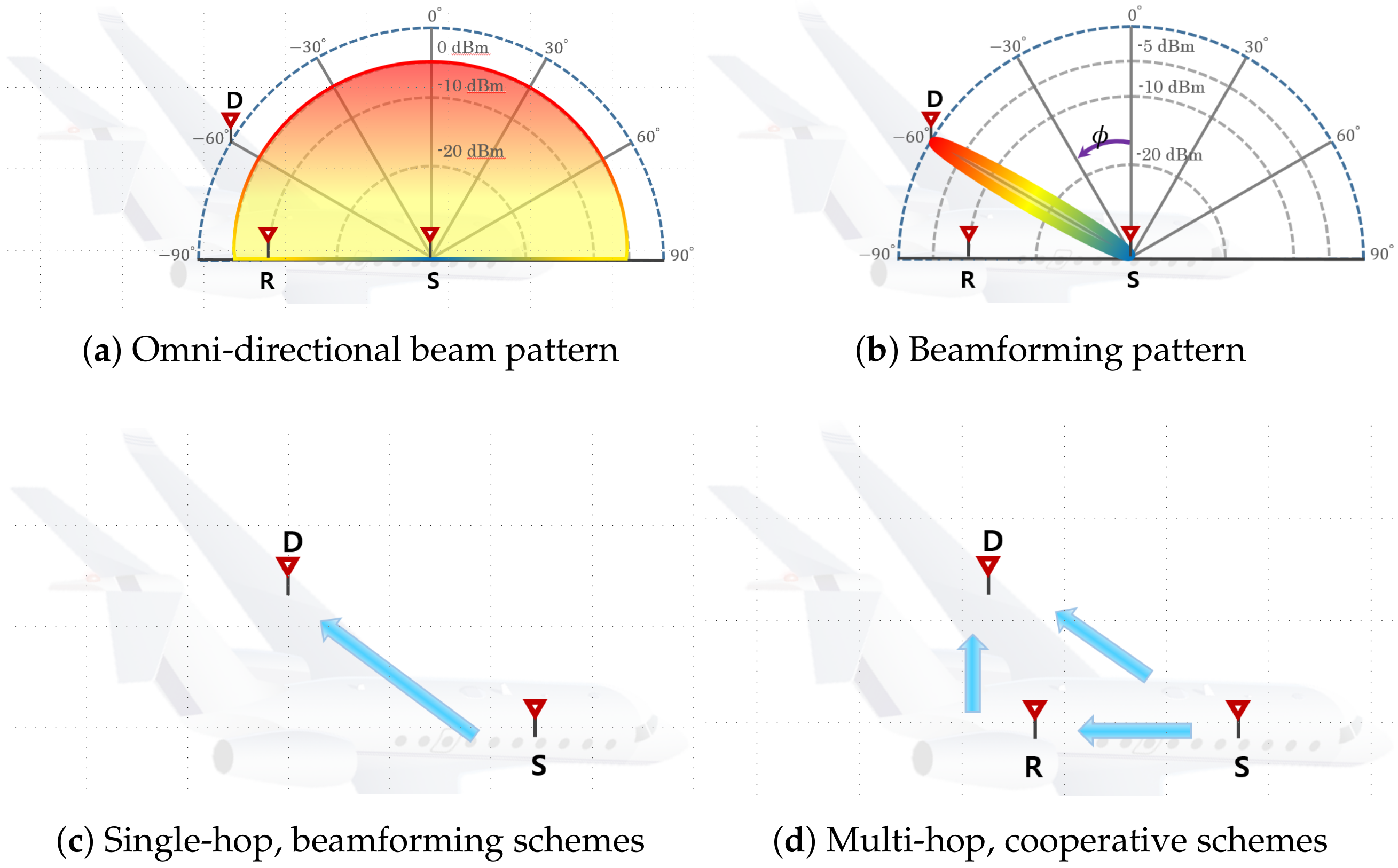

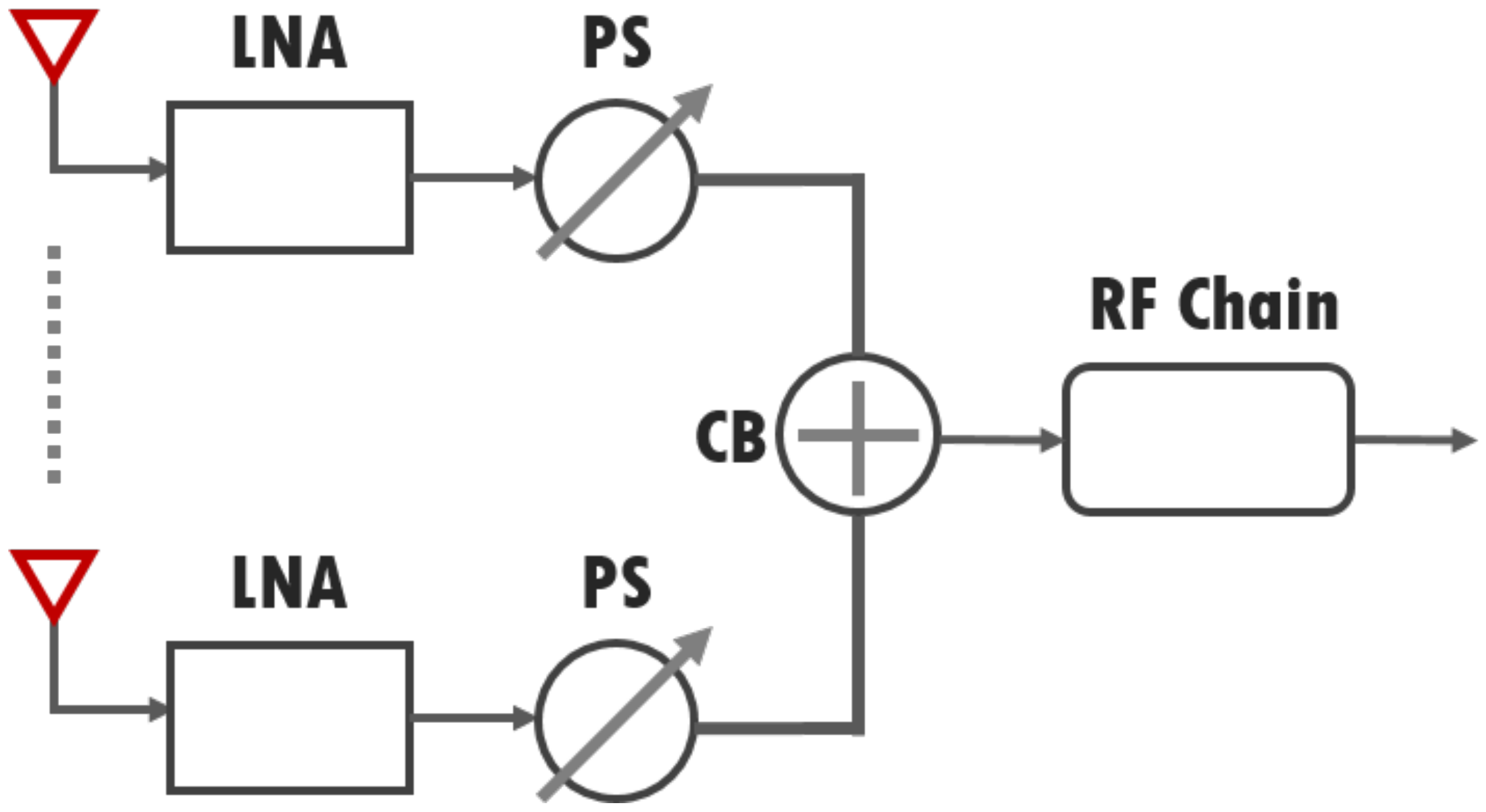
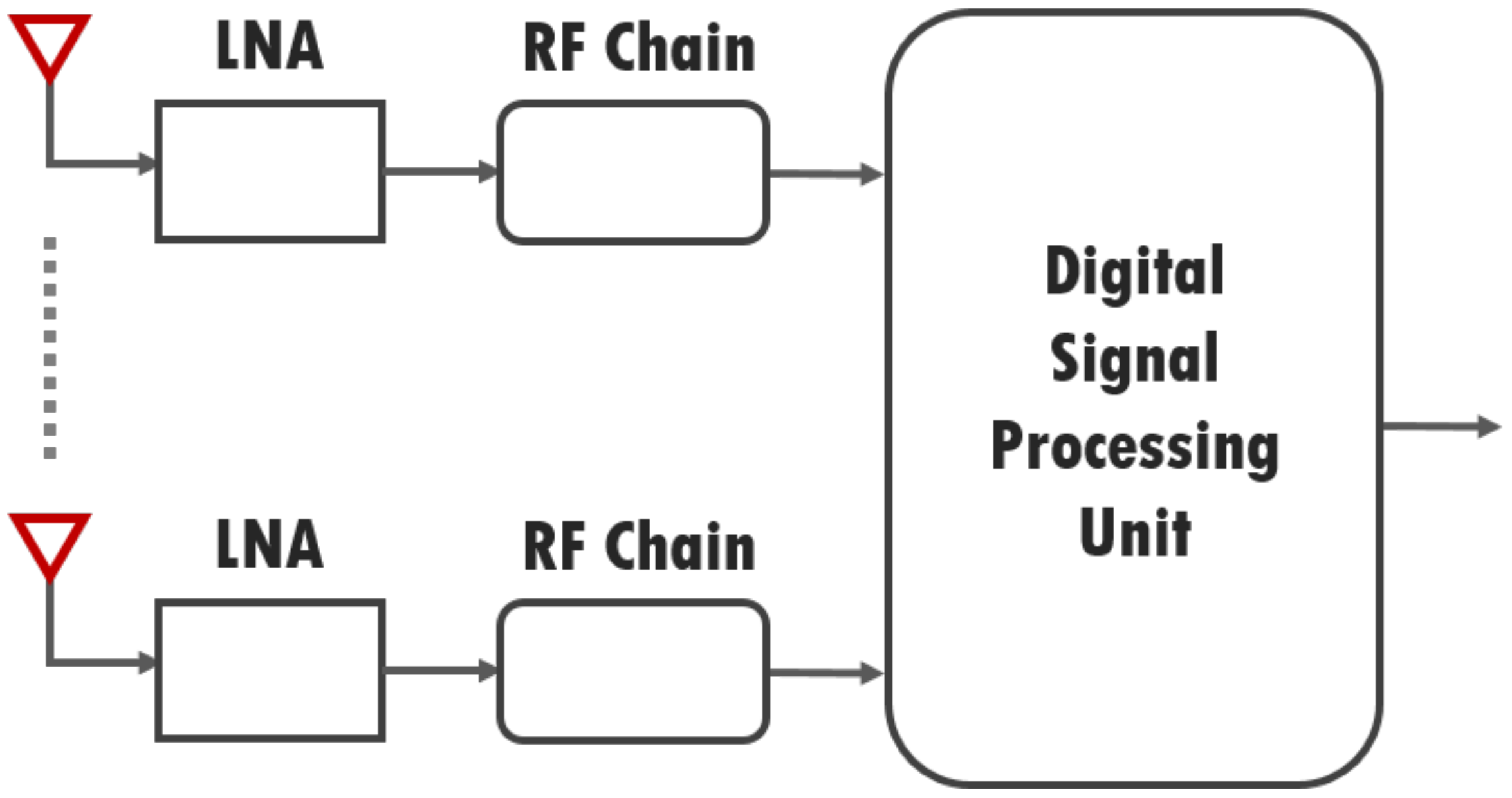

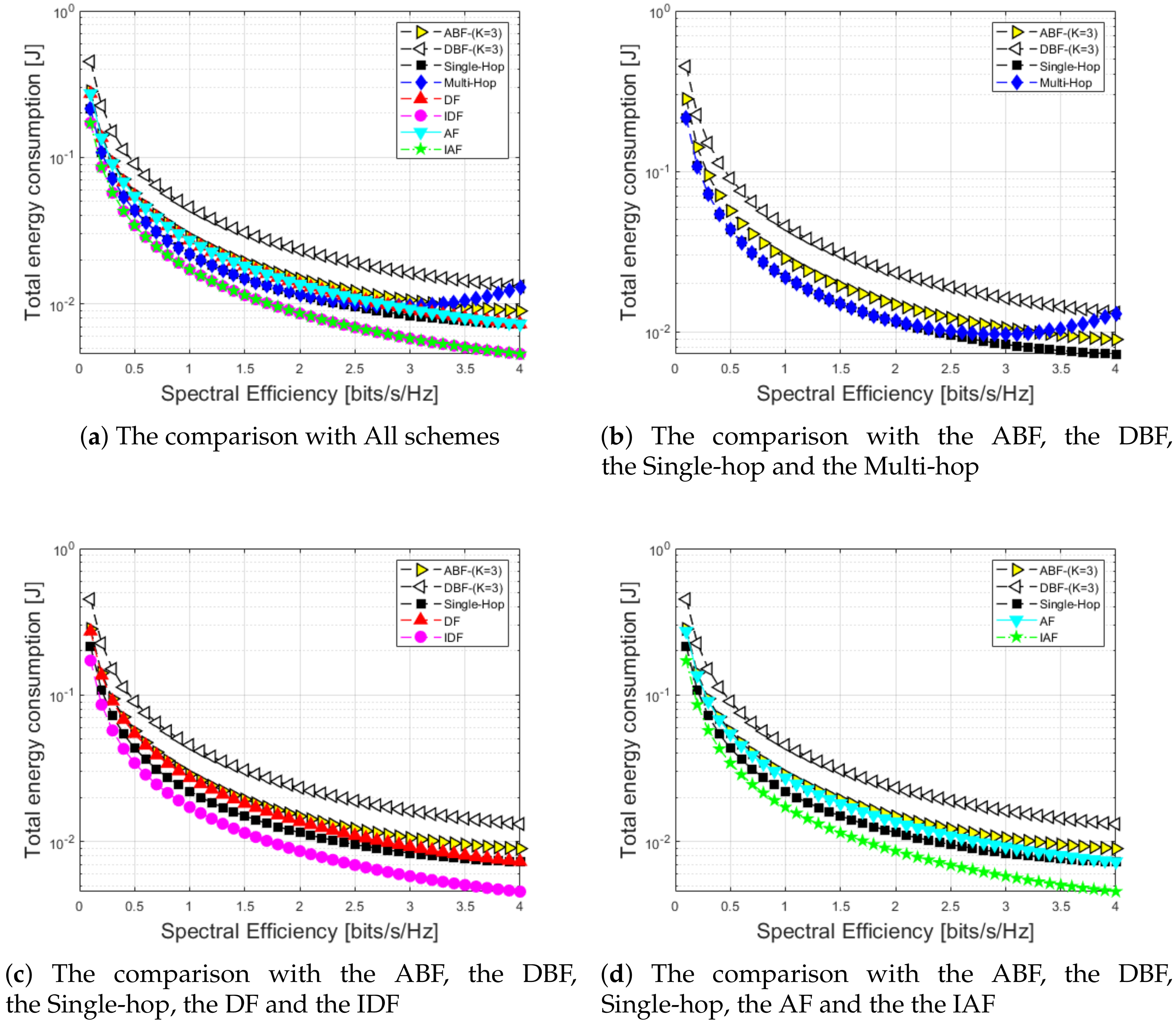
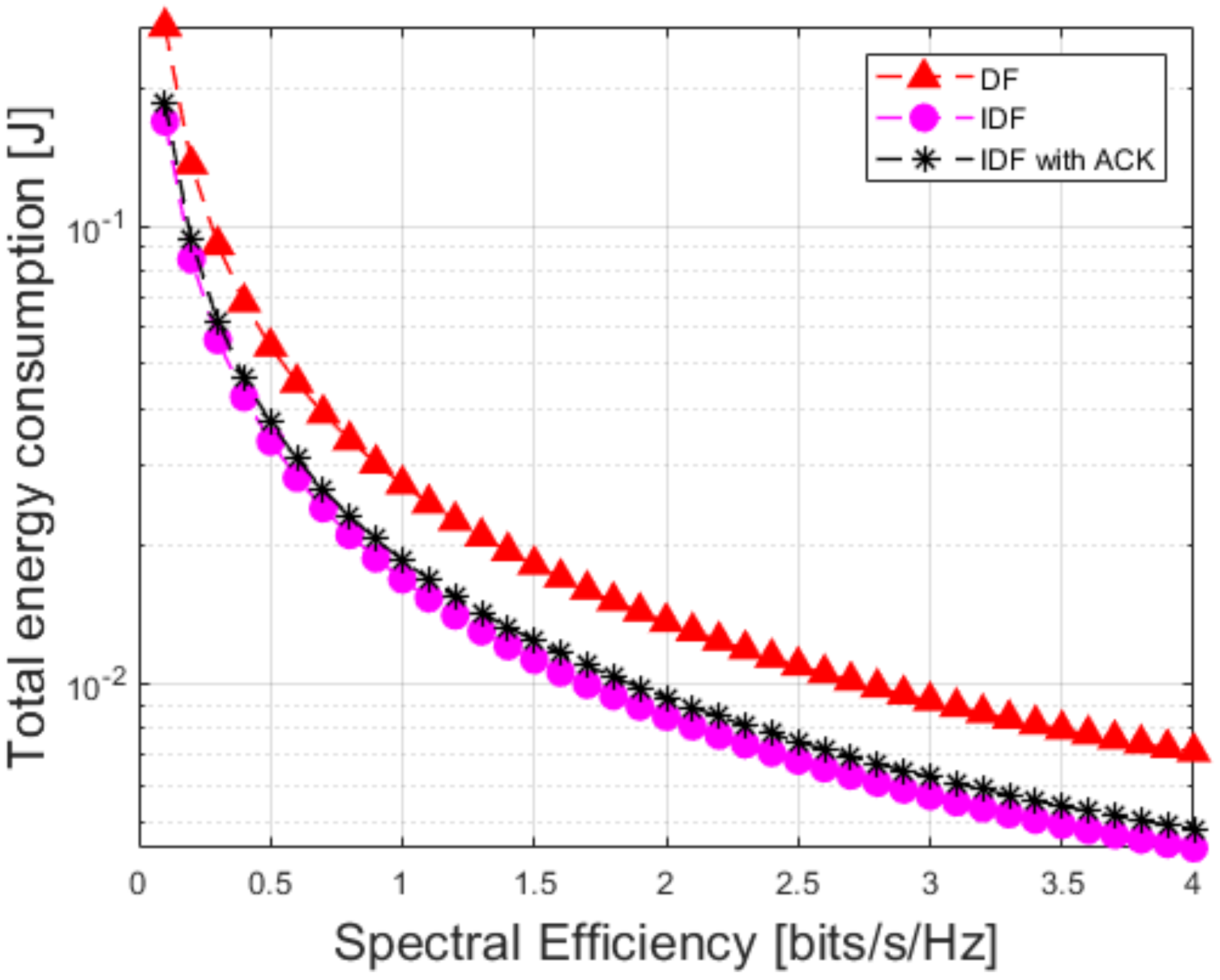
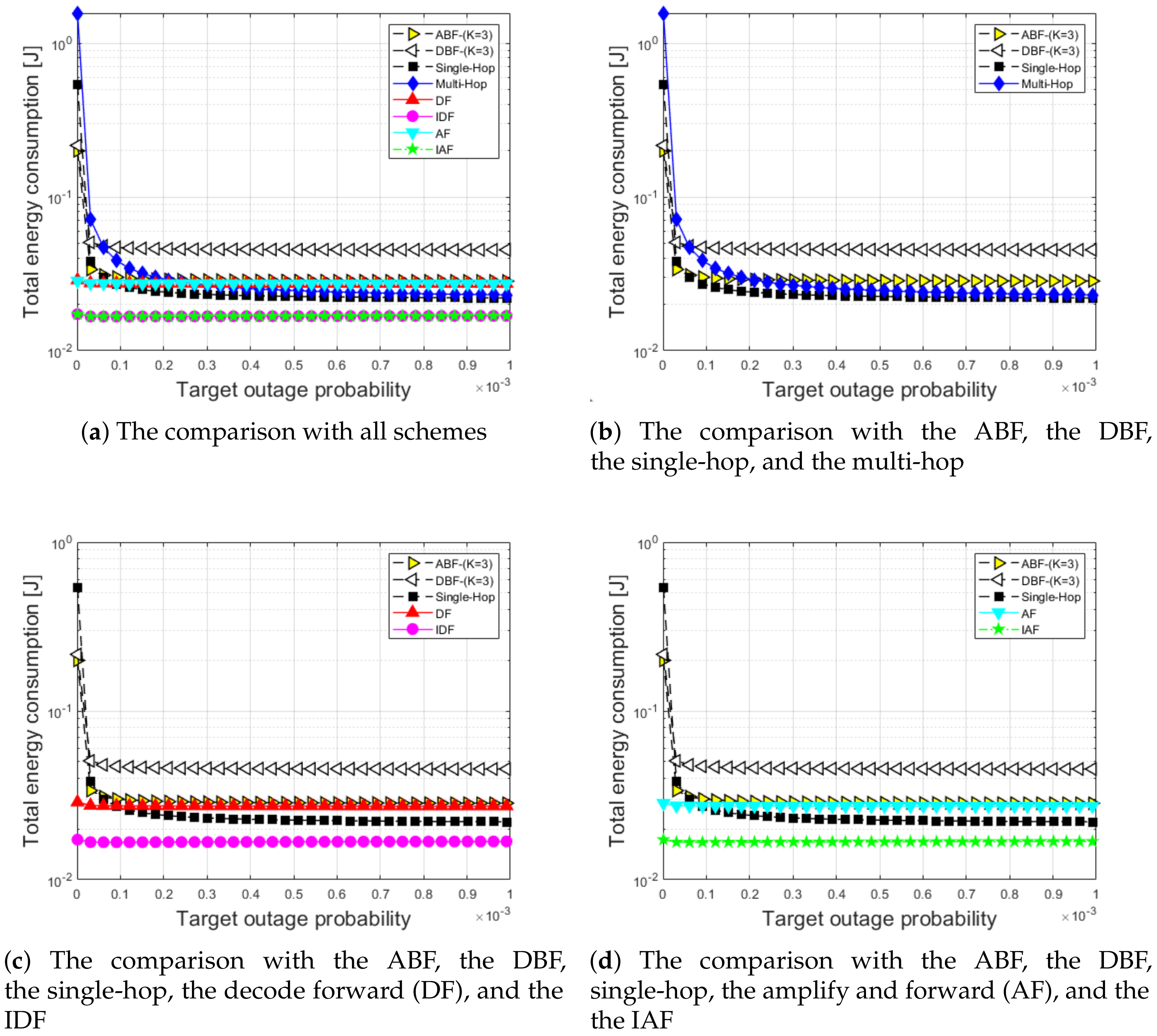


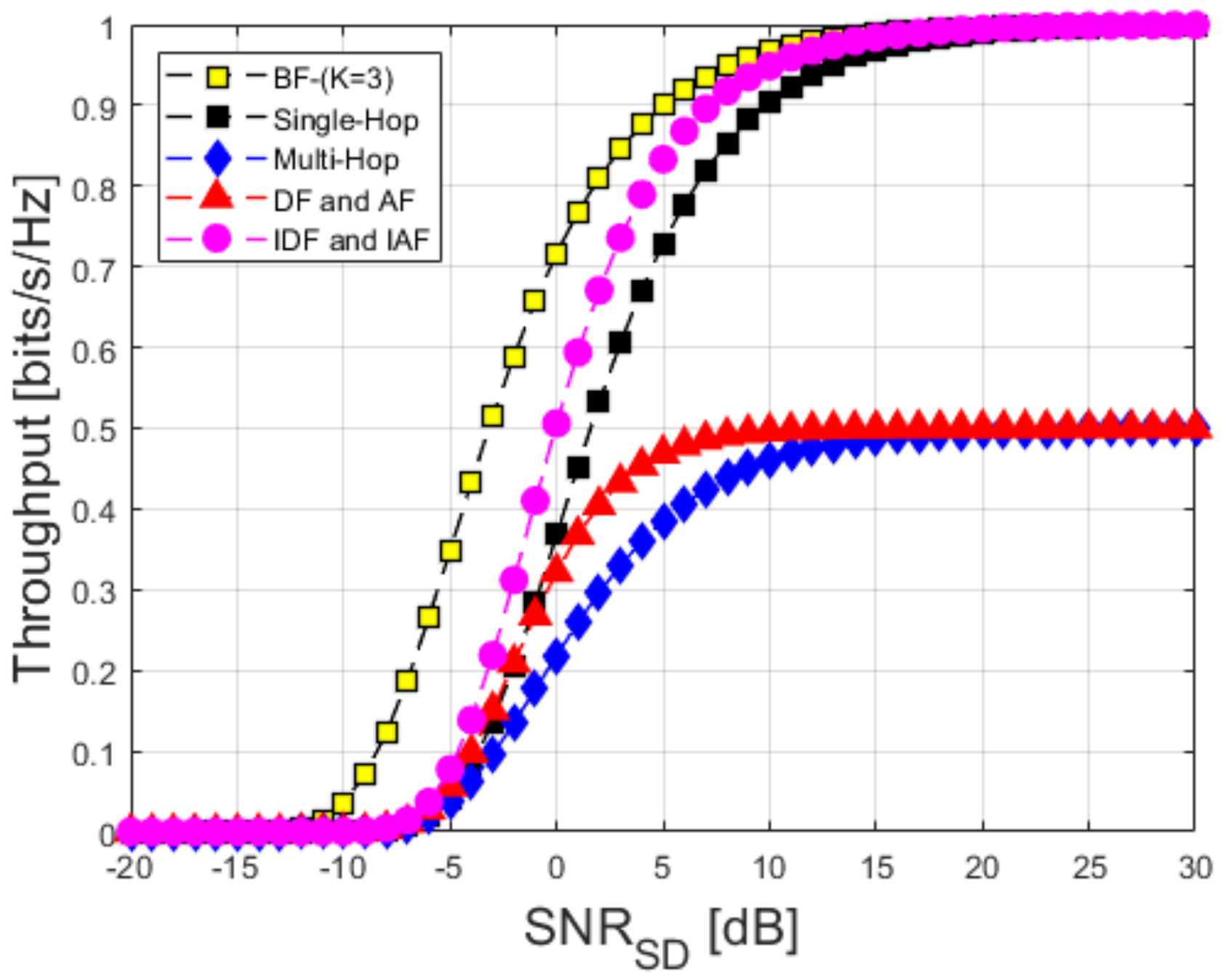
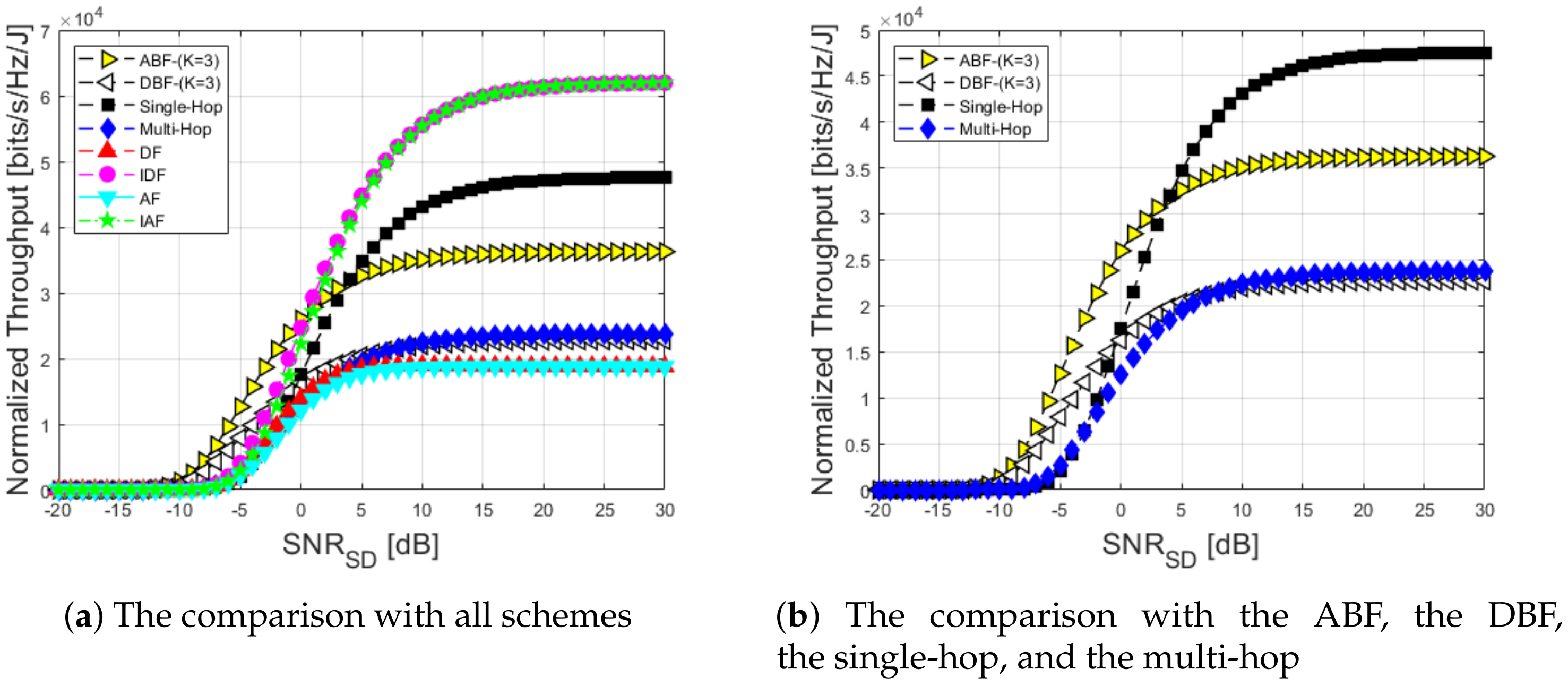
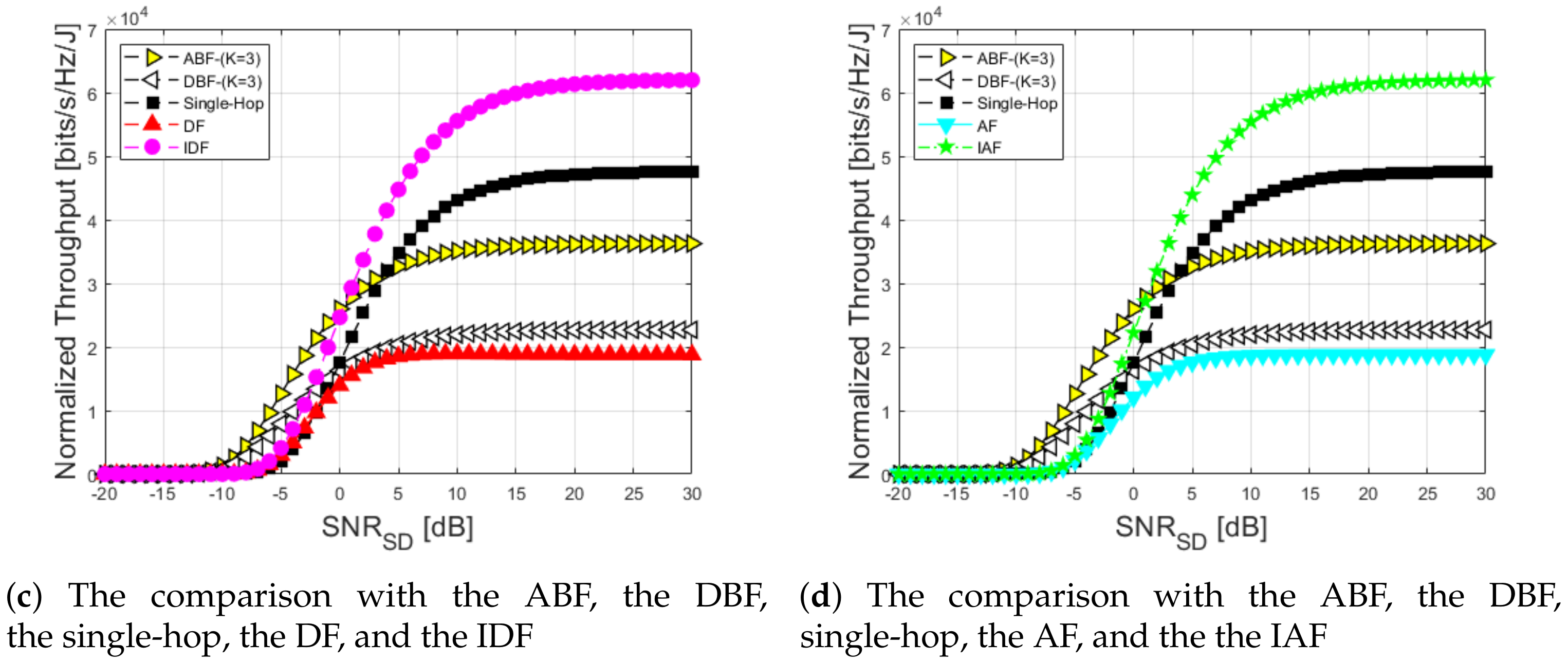
| Group | Group Name | k | n | [dB] |
|---|---|---|---|---|
| A | Intra-Flight Deck | 2.45 | 2.00 | 189.8 |
| B | Inter-Cabin | 2.09 | 3.46 | 167.5 |
| C | Inter-Cabin-to-Lower Lobe | 1.86 | 2.49 | 124.5 |
| D | Inter-Cabin-to-Exterior | 1.86 | 2.12 | 118.2 |
| E | Inter-Cabin-to-Landing Gear | 1.59 | 1.51 | 77.9 |
| F | Inter-Exterior | 1.95 | 2.31 | 142.5 |
| Parameter | Parameter Value |
|---|---|
| BPSK modulation | M = 2 |
| Center frequency | = 4.3 GHz |
| Bandwidth | B = 10 Kbps |
| Target outage probability | = |
| Packet size | = 1024 bit |
| Shadowing fading | = 4 dB |
| Distance from S to D | d = 10 m |
| Number of antenna | K = 3 |
| Drain efficiency | = 0.35 |
| Peak to average ratio | = 1.761 dB |
| Source voltage | = 3 V |
| Source current | = 10 A |
| Parasitic capacitance | C = 1 pF |
| Corner frequency | = 1 MHz |
| Minimum channel length | = 0.5 m |
| Filter power consumption | = 2.5 mW |
| Synthesizer power consumption | = 50 mW |
| IFA power consumption | = 3 mW |
| LNA power consumption | = 20 mW |
© 2020 by the authors. Licensee MDPI, Basel, Switzerland. This article is an open access article distributed under the terms and conditions of the Creative Commons Attribution (CC BY) license (http://creativecommons.org/licenses/by/4.0/).
Share and Cite
Kim, S.-H.; Kim, J.-W.; Kim, D.-S. Energy Consumption Analysis of Beamforming and Cooperative Schemes for Aircraft Wireless Sensor Networks. Appl. Sci. 2020, 10, 4374. https://doi.org/10.3390/app10124374
Kim S-H, Kim J-W, Kim D-S. Energy Consumption Analysis of Beamforming and Cooperative Schemes for Aircraft Wireless Sensor Networks. Applied Sciences. 2020; 10(12):4374. https://doi.org/10.3390/app10124374
Chicago/Turabian StyleKim, Seung-Hwan, Jae-Woo Kim, and Dong-Seong Kim. 2020. "Energy Consumption Analysis of Beamforming and Cooperative Schemes for Aircraft Wireless Sensor Networks" Applied Sciences 10, no. 12: 4374. https://doi.org/10.3390/app10124374
APA StyleKim, S.-H., Kim, J.-W., & Kim, D.-S. (2020). Energy Consumption Analysis of Beamforming and Cooperative Schemes for Aircraft Wireless Sensor Networks. Applied Sciences, 10(12), 4374. https://doi.org/10.3390/app10124374






